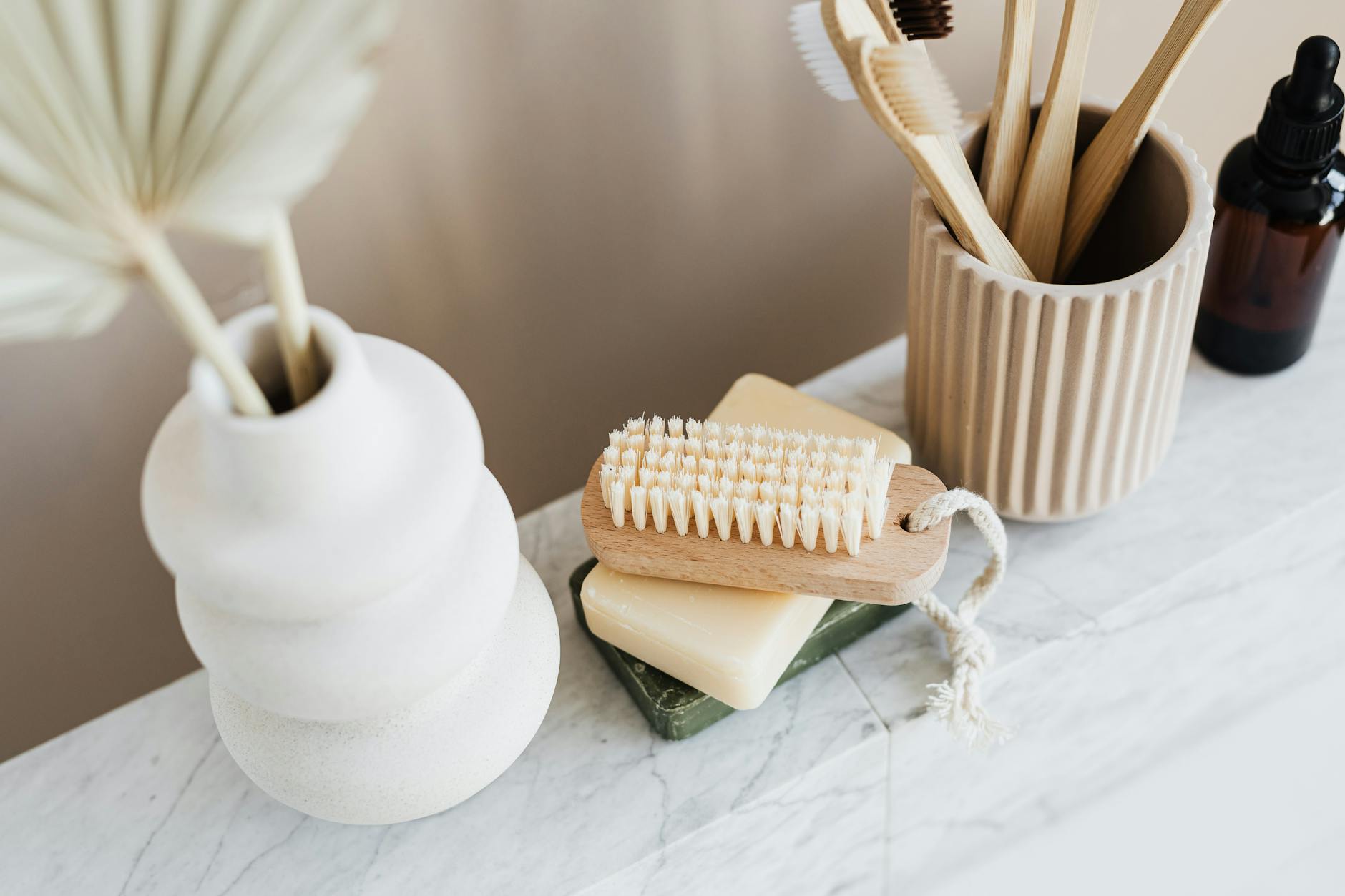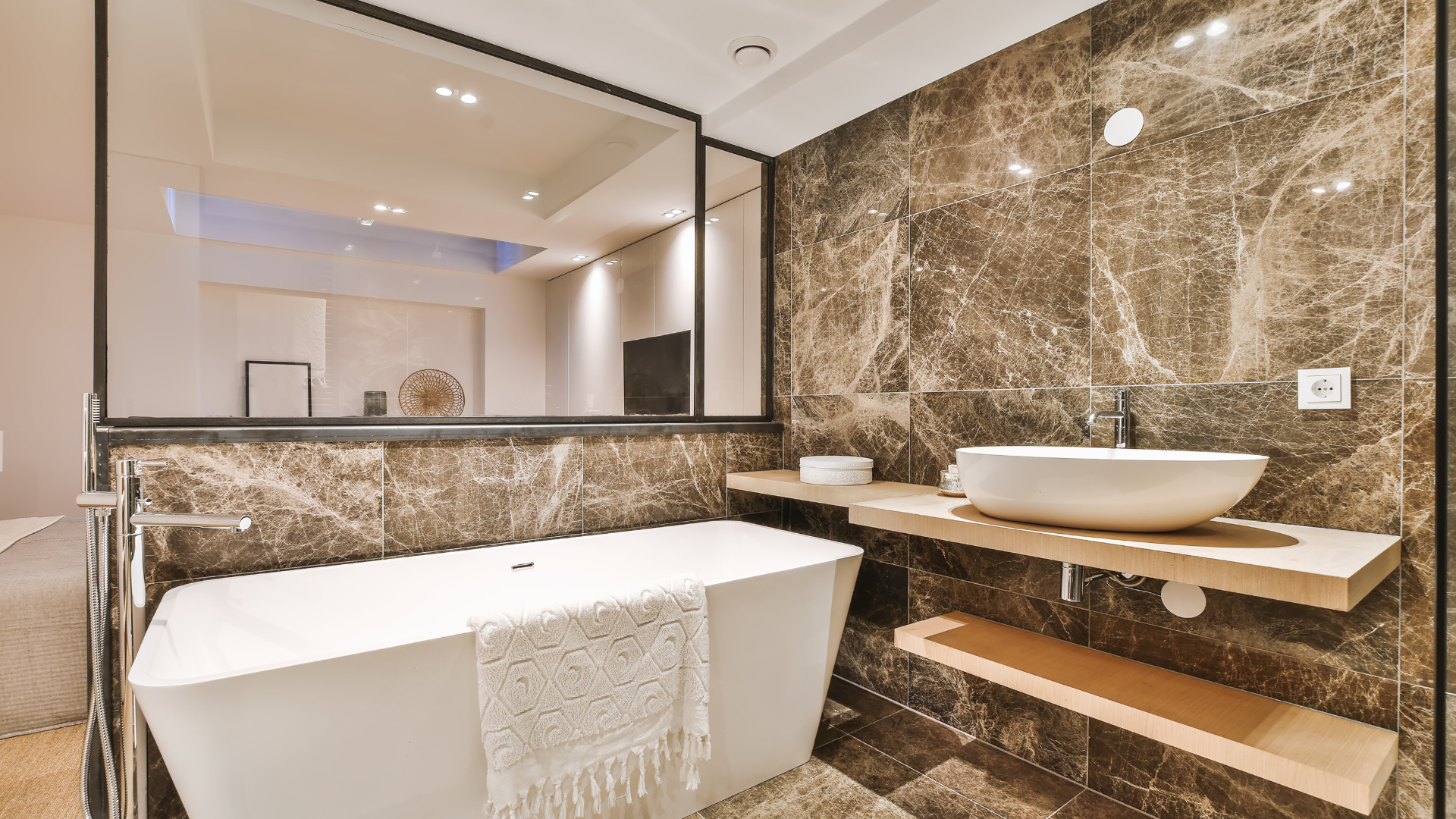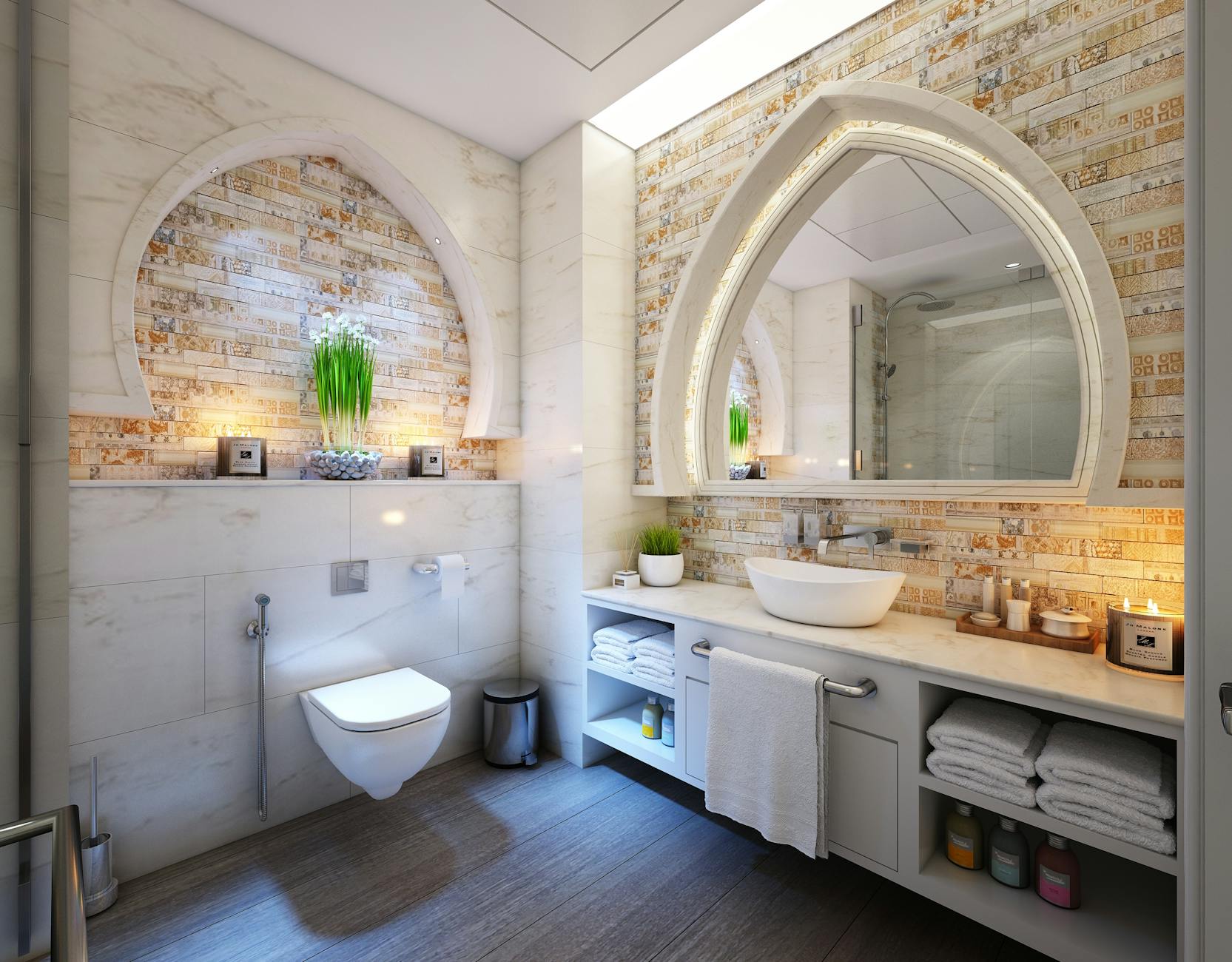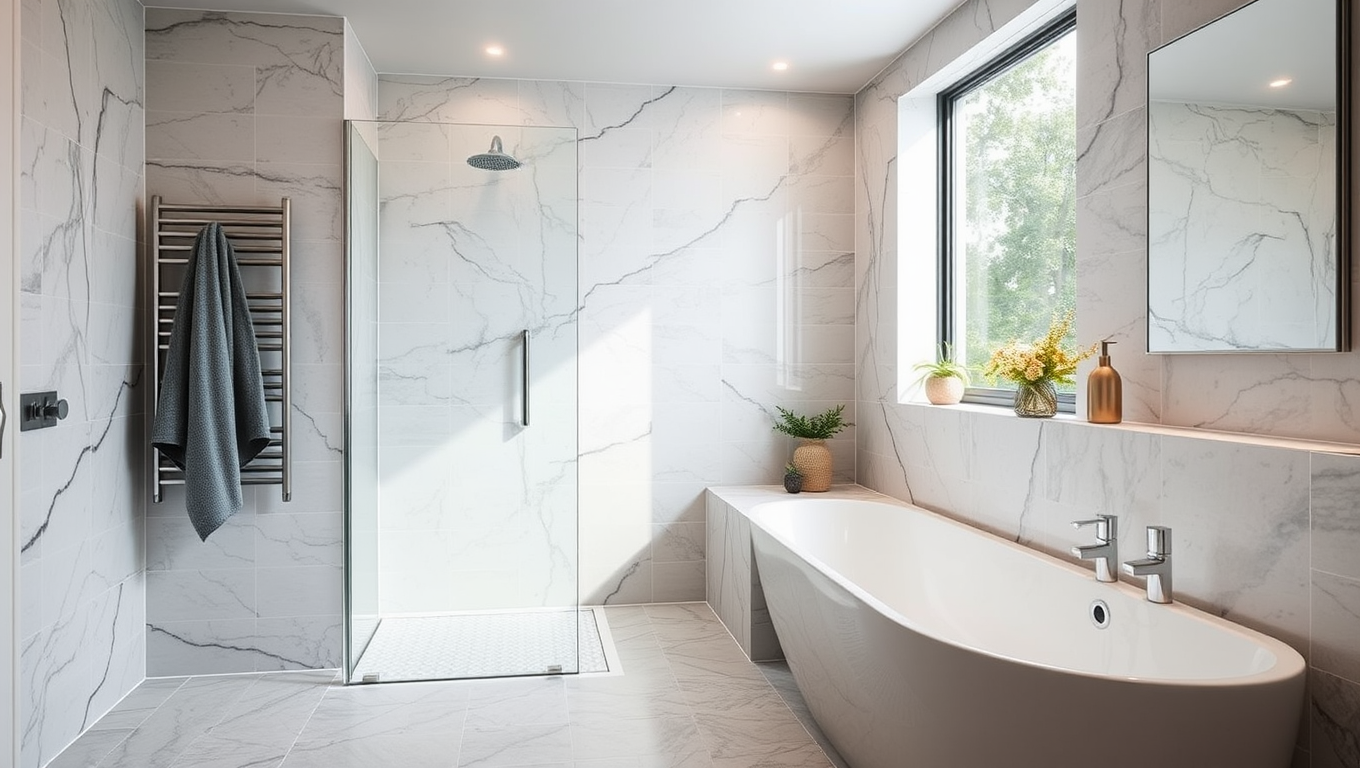? 🌿🚿 From water waste to energy consumption an eco-friendly bathroom can have a big impact on the environment.
By making a few simple changes and smart product choices, you can create a bathroom that’s not just clean and functional, but also kind to the planet.

Understanding Bathroom Sustainability
As you embark on your journey to create a more eco-friendly living space, it’s crucial to understand the concept of bathroom sustainability. Your bathroom, although often overlooked, plays a significant role in your home’s overall environmental impact. Let’s explore why sustainable bathroom practices are essential and how you can make a positive change.
A. Environmental impact of traditional bathrooms
Traditional bathrooms can be surprisingly resource-intensive and environmentally unfriendly. Here’s a breakdown of their impact:
- Water consumption: The average person uses about 80-100 gallons of water per day, with a significant portion used in the bathroom.
- Energy usage: Water heating accounts for approximately 18% of a home’s energy use, with much of this hot water used in bathrooms.
- Waste generation: From disposable products to packaging, bathrooms contribute considerably to household waste.
- Chemical pollution: Many conventional cleaning products contain harsh chemicals that harm aquatic ecosystems.
B. Benefits of sustainable bathroom practices
Adopting sustainable bathroom practices offers numerous advantages:
- Reduced utility bills: Water-saving fixtures and energy-efficient appliances can significantly lower your monthly expenses.
- Improved home value: Eco-friendly bathrooms are increasingly attractive to potential buyers.
- Healthier living environment: Using natural materials and non-toxic products creates a safer space for you and your family.
- Reduced carbon footprint: By conserving resources, you’re actively contributing to environmental protection.
- Enhanced aesthetic appeal: Many sustainable bathroom products boast sleek, modern designs.
| Benefit | Description |
|---|---|
| Financial savings | Lower water and energy bills |
| Environmental impact | Reduced resource consumption and pollution |
| Health improvements | Fewer toxic chemicals in your living space |
| Increased home value | Eco-friendly features attract buyers |
| Personal satisfaction | Knowing you’re making a positive difference |
C. Key areas for improvement
To create a truly sustainable bathroom, you’ll need to focus on several key areas:
- Water conservation: Implementing water-saving fixtures and adopting mindful usage habits.
- Energy efficiency: Using energy-efficient lighting, appliances, and water heating systems.
- Eco-friendly materials: Choosing sustainable materials for flooring, countertops, and other bathroom elements.
- Waste reduction: Minimizing single-use products and embracing reusable alternatives.
- Green cleaning practices: Opting for natural, non-toxic cleaning products and methods.
- Proper ventilation: Ensuring good air circulation to prevent mold growth and improve indoor air quality.
- Smart product choices: Selecting bathroom products from sustainable brands committed to eco-friendly practices.
By addressing these areas, you’ll be well on your way to creating a bathroom that’s not only functional and beautiful but also kind to the planet. As you move forward, you’ll discover that water conservation is a critical aspect of bathroom sustainability.

Water Conservation Strategies
Now that you understand the importance of bathroom sustainability, let’s dive into one of the most crucial aspects: water conservation. By implementing these strategies, you can significantly reduce your water consumption and create a more eco-friendly bathroom.
A. Low-flow fixtures and faucets
Low-flow fixtures are an excellent way to conserve water without sacrificing functionality. By installing these devices, you can reduce your water usage by up to 60%. Here are some options to consider:
- Low-flow showerheads: These can save up to 2.5 gallons per minute compared to standard showerheads.
- Faucet aerators: These simple attachments mix air with water, reducing flow while maintaining pressure.
- Touchless faucets: These automatically shut off when not in use, preventing unnecessary water waste.
| Fixture Type | Standard Flow Rate | Low-Flow Rate | Potential Savings |
|---|---|---|---|
| Showerhead | 2.5+ gpm | 1.5-2.0 gpm | Up to 40% |
| Faucet | 2.2+ gpm | 1.0-1.5 gpm | Up to 55% |
| Toilet | 3.5+ gpf | 1.28-1.6 gpf | Up to 63% |
gpm = gallons per minute, gpf = gallons per flush
B. Dual-flush toilets
Dual-flush toilets are a game-changer in water conservation. They offer two flush options:
- A light flush for liquid waste (typically 0.8-1.1 gallons)
- A full flush for solid waste (around 1.6 gallons)
By choosing the appropriate flush, you can save thousands of gallons of water annually. Many modern dual-flush toilets also feature sleek designs that complement your bathroom’s aesthetic.
C. Greywater recycling systems
Greywater recycling is an innovative way to reuse water from sinks, showers, and washing machines. This lightly used water can be repurposed for:
- Toilet flushing
- Garden irrigation
- Outdoor cleaning
While installing a greywater system may require a larger investment, it can lead to significant water savings in the long run. Be sure to check local regulations before implementing a greywater system in your home.
D. Water-saving habits
In addition to installing water-efficient fixtures, adopting water-saving habits can further reduce your consumption:
- Take shorter showers: Aim for 5 minutes or less.
- Turn off the tap: When brushing teeth or shaving, only run water when needed.
- Fix leaks promptly: A dripping faucet can waste up to 20 gallons per day.
- Use a bucket: Collect water while waiting for the shower to warm up and use it for plants or cleaning.
By implementing these water conservation strategies, you’ll not only reduce your environmental impact but also lower your water bills. Remember, every drop counts in creating a more sustainable bathroom.

Energy-Efficient Bathroom Solutions
Now that you’ve learned about water conservation strategies, let’s explore energy-efficient solutions for your bathroom. These innovations not only reduce your carbon footprint but also lead to significant savings on your energy bills.
LED Lighting Options
You can dramatically decrease your bathroom’s energy consumption by switching to LED lighting. LED bulbs use up to 75% less energy than traditional incandescent bulbs and last much longer. Here are some LED options for your bathroom:
- Recessed ceiling lights
- Vanity mirror lights
- Shower lights
- Accent lighting for shelves or artwork
| LED Bulb Type | Energy Savings | Lifespan |
|---|---|---|
| A19 | Up to 80% | 25,000 hours |
| BR30 | Up to 85% | 22,000 hours |
| GU10 | Up to 80% | 15,000 hours |
Solar-Powered Water Heaters
You can harness the sun’s energy to heat your bathroom water with solar-powered water heaters. These systems can provide up to 80% of your hot water needs, significantly reducing your reliance on grid electricity or gas. Consider these types:
- Active systems: Use pumps to circulate water
- Passive systems: Rely on natural convection
- Evacuated tube collectors: Highly efficient in colder climates
- Flat plate collectors: More affordable and suitable for warmer regions
Energy-Efficient Ventilation Systems
Proper ventilation is crucial for maintaining a healthy bathroom environment. You can opt for energy-efficient ventilation systems that remove moisture and odors while consuming minimal power. Look for these features:
- Energy Star certified fans
- Humidity-sensing controls
- Timer switches
- Low sone ratings for quieter operation
Smart Temperature Controls
You can optimize your bathroom’s energy use with smart temperature controls. These systems allow you to:
- Set schedules for heating and cooling
- Control temperatures remotely via smartphone apps
- Integrate with other smart home devices
- Learn your preferences and adjust automatically
| Smart Thermostat Feature | Benefit |
|---|---|
| Geofencing | Adjusts based on your location |
| Weather Integration | Optimizes settings based on forecast |
| Energy Reports | Provides insights on consumption |
| Voice Control | Allows hands-free operation |
By implementing these energy-efficient solutions, you’ll create a more sustainable bathroom that’s kinder to the environment and your wallet. From LED lighting that brightens your space while using less power, to solar water heaters that harness renewable energy, each upgrade contributes to a greener home. Smart temperature controls and efficient ventilation systems further enhance your bathroom’s performance, ensuring comfort without waste.
As you consider these energy-saving options, remember that they often work best when combined. For instance, pairing LED lights with smart controls can maximize your energy savings. Similarly, a solar water heater coupled with an energy-efficient ventilation system creates a comprehensive approach to sustainability.

Eco-Friendly Materials and Products
Now that you’ve learned about energy-efficient solutions for your bathroom, let’s explore eco-friendly materials and products that can further enhance your sustainable bathroom experience. By choosing environmentally conscious options, you’ll not only reduce your carbon footprint but also create a healthier living space for you and your family.
Sustainable Flooring Options
When it comes to bathroom flooring, you have several eco-friendly choices that combine durability with sustainability:
- Cork: A renewable resource that’s naturally water-resistant and comfortable underfoot
- Bamboo: Fast-growing and highly renewable, offering a unique aesthetic
- Recycled glass tiles: Durable, water-resistant, and available in various colors and patterns
Here’s a comparison of these sustainable flooring options:
| Material | Pros | Cons |
|---|---|---|
| Cork | Water-resistant, comfortable, renewable | May require periodic sealing |
| Bamboo | Durable, fast-growing, unique look | Can be prone to water damage if not properly sealed |
| Recycled glass tiles | Waterproof, variety of designs, eco-friendly | Can be slippery when wet, higher installation cost |
Recycled and Recyclable Bathroom Accessories
You can easily incorporate recycled and recyclable materials into your bathroom decor:
- Recycled glass soap dispensers and toothbrush holders
- Bamboo toilet paper holders and towel racks
- Upcycled mason jars for storage
- Recycled plastic shower curtains
These options not only reduce waste but also add a unique touch to your bathroom’s aesthetic.
Natural and Organic Personal Care Products
Switching to natural and organic personal care products can significantly reduce your environmental impact:
- Organic shampoos and conditioners
- Natural, biodegradable soaps
- Bamboo toothbrushes with natural bristles
- Organic cotton towels and washcloths
By choosing these products, you’ll avoid harmful chemicals and support sustainable manufacturing practices.
Biodegradable Cleaning Supplies
Keep your bathroom clean without harming the environment by using biodegradable cleaning supplies:
- Vinegar and baking soda for general cleaning
- Enzymatic cleaners for drains
- Microfiber cloths for dusting and wiping
- Natural essential oils for fragrance
These options are effective, eco-friendly, and often more cost-effective than conventional cleaning products.
Plastic-Free Alternatives
Reducing plastic use in your bathroom is crucial for sustainability. Consider these plastic-free alternatives:
- Glass or stainless steel containers for toiletries
- Solid shampoo and conditioner bars
- Reusable cotton pads for makeup removal
- Bamboo cotton swabs
By implementing these eco-friendly materials and products in your bathroom, you’ll create a space that’s not only sustainable but also stylish and functional. Remember, every small change contributes to a greener future.

Waste Reduction in the Bathroom
Now that you’ve learned about eco-friendly materials and products, let’s focus on how you can minimize waste in your bathroom. By implementing these strategies, you’ll significantly reduce your environmental impact and create a more sustainable space.
A. Reusable alternatives to disposable items
You can easily replace many single-use bathroom items with reusable alternatives:
- Swap disposable cotton pads for washable, reusable cotton rounds
- Replace plastic razors with a safety razor or electric shaver
- Use a menstrual cup or period underwear instead of disposable sanitary products
- Opt for bamboo toothbrushes and compostable dental floss
Here’s a comparison of common disposable items and their reusable counterparts:
| Disposable Item | Reusable Alternative | Environmental Impact |
|---|---|---|
| Cotton pads | Washable cotton rounds | Reduces textile waste |
| Plastic razors | Safety razor | Minimizes plastic waste |
| Sanitary products | Menstrual cup/period underwear | Decreases landfill waste |
| Plastic toothbrush | Bamboo toothbrush | Biodegradable alternative |
B. Composting toilets and their benefits
You might consider installing a composting toilet to significantly reduce water usage and create nutrient-rich compost. Benefits include:
- Water conservation
- Reduced strain on sewage systems
- Production of valuable fertilizer
- Lower environmental impact
While composting toilets may require an initial adjustment, they’re an excellent long-term solution for sustainable waste management in your bathroom.
C. Proper disposal of bathroom waste
Ensure you’re disposing of bathroom waste correctly to minimize environmental impact:
- Separate recyclables (e.g., empty shampoo bottles, toilet paper rolls)
- Avoid flushing non-biodegradable items
- Use a small trash can with a lid for non-recyclable waste
- Consider composting appropriate organic waste (e.g., hair, nail clippings)
D. Upcycling and repurposing bathroom items
Get creative with upcycling and repurposing to give new life to old bathroom items:
- Turn empty glass jars into storage containers for cotton swabs or bath salts
- Repurpose old towels as cleaning rags
- Use an old shower curtain as a drop cloth for painting projects
- Transform empty toilet paper rolls into seed starters for your garden
By implementing these waste reduction strategies, you’ll create a more sustainable bathroom environment. Remember, small changes can lead to significant impact over time. As you adopt these practices, you’ll notice a reduction in your overall waste production and a more eco-friendly bathroom space.

Green Bathroom Renovations
Now that you’ve learned about various sustainable bathroom practices, let’s explore how to incorporate these principles into your bathroom renovation project. Green bathroom renovations not only benefit the environment but can also lead to long-term cost savings and improved home value.
Choosing sustainable bathroom fixtures
When selecting fixtures for your eco-friendly bathroom, prioritize water-saving options. Look for products with WaterSense labels, which indicate they meet EPA standards for water efficiency. Here’s a comparison of traditional fixtures versus their sustainable counterparts:
| Fixture Type | Traditional Water Usage | Sustainable Water Usage | Potential Water Savings |
|---|---|---|---|
| Toilet | 3.5-7 gallons per flush | 1.28 gallons per flush | Up to 60% |
| Showerhead | 2.5 gallons per minute | 1.5 gallons per minute | Up to 40% |
| Faucet | 2.2 gallons per minute | 1.5 gallons per minute | Up to 30% |
Choose low-flow showerheads, dual-flush toilets, and sensor-activated faucets to significantly reduce your water consumption without compromising functionality.
Eco-friendly paint and wallpaper options
When it comes to decorating your bathroom walls, opt for eco-friendly paints and wallpapers. Look for products with the following characteristics:
- Low or zero VOC (Volatile Organic Compounds)
- Non-toxic and free from harmful chemicals
- Made from recycled or sustainable materials
- Water-based formulas
These options not only reduce your environmental impact but also contribute to better indoor air quality, which is crucial in a small, often humid space like a bathroom.
Maximizing natural light and ventilation
Incorporating natural light and proper ventilation in your bathroom design can significantly reduce energy consumption and prevent moisture-related issues. Consider these strategies:
- Install larger windows or skylights to increase natural light
- Use light-colored materials to reflect and amplify available light
- Install energy-efficient exhaust fans with humidity sensors
- Incorporate operable windows for natural ventilation when weather permits
By maximizing natural light, you’ll reduce the need for artificial lighting during the day, while proper ventilation helps prevent mold growth and maintains good air quality.
Incorporating plants for air purification
Adding plants to your bathroom not only enhances its aesthetic appeal but also improves air quality. Some bathroom-friendly plants that thrive in humid environments and help purify the air include:
- Snake Plant (Sansevieria)
- Spider Plant (Chlorophytum comosum)
- Boston Fern (Nephrolepis exaltata)
- Peace Lily (Spathiphyllum)
- Aloe Vera
These plants can help remove toxins from the air, increase humidity, and create a more relaxing atmosphere in your bathroom.
By implementing these green renovation strategies, you’ll create a bathroom that’s not only visually appealing but also environmentally responsible. As you plan your renovation, consider consulting with sustainable design professionals to ensure you’re making the most eco-friendly choices for your specific space and needs.

Sustainable Bathroom Brands and Products
Now that we’ve explored various aspects of creating a sustainable bathroom, let’s dive into some of the top brands and products that can help you achieve your eco-friendly goals. From manufacturers to specific items, we’ll guide you through the best options for a greener bathroom experience.
Top eco-friendly bathroom manufacturers
When it comes to sustainable bathroom products, these manufacturers stand out:
- Kohler: Known for their water-saving fixtures and innovative designs
- TOTO: Pioneers in low-flow toilets and eco-friendly technology
- Moen: Offers a wide range of water-efficient faucets and showerheads
- Grohe: Focuses on sustainable production and water-saving products
- American Standard: Provides affordable and eco-friendly bathroom solutions
| Manufacturer | Specialties | Notable Products |
|---|---|---|
| Kohler | Water-saving fixtures | Touchless faucets, dual-flush toilets |
| TOTO | Low-flow toilets | WASHLET bidet seats, ultra-low-flow urinals |
| Moen | Water-efficient faucets | Magnetix showerheads, MotionSense faucets |
| Grohe | Sustainable production | EcoJoy technology, rainshower systems |
| American Standard | Affordable eco-solutions | H2Option toilets, FloWise showerheads |
Recommended sustainable toiletries
You can make a significant impact by switching to eco-friendly toiletries:
- Bamboo toothbrushes (e.g., Brush with Bamboo, The Humble Co.)
- Plastic-free dental floss (e.g., Dental Lace, Terra & Co.)
- Solid shampoo and conditioner bars (e.g., Lush, Ethique)
- Biodegradable body wash (e.g., Dr. Bronner’s, Plaine Products)
- Reusable cotton rounds (e.g., LastObject, Marley’s Monsters)
Eco-certified bathroom cleaning products
Keep your bathroom clean and green with these certified eco-friendly products:
- Method: Plant-based, biodegradable all-purpose cleaners
- Seventh Generation: EPA Safer Choice certified bathroom cleaners
- Ecover: Phosphate-free toilet cleaners and surface sprays
- Blueland: Refillable cleaning tablets to reduce plastic waste
- Attitude: EWG Verified bathroom cleaning products
Water-saving shower heads and faucets
Upgrade your fixtures to conserve water without sacrificing performance:
- Nebia by Moen Spa Shower: Uses atomization technology to reduce water usage by up to 65%
- High Sierra’s All Metal Low Flow Showerhead: Delivers a strong spray while using only 1.5 GPM
- Delta H2Okinetic Showerheads: Sculpts water into a unique wave pattern for better coverage
- WaterSense-labeled faucets: Look for this EPA certification to ensure water efficiency
- Kohler Purist Bathroom Sink Faucet: Combines style with a flow rate of just 1.2 GPM
By choosing products from these sustainable bathroom brands, you’re not only creating a more eco-friendly space but also supporting companies that prioritize environmental responsibility. Remember, every small change adds up to make a significant difference in your bathroom’s sustainability. In the next section, we’ll explore how to incorporate these products and brands into your overall bathroom design for a cohesive, green renovation project.

Transforming your bathroom into a sustainable oasis is not just about eco-friendly products; it’s a holistic approach that encompasses water conservation, energy efficiency, and waste reduction. By implementing the strategies and product recommendations discussed in this post, you can significantly reduce your environmental impact while creating a more functional and aesthetically pleasing space.
Remember, every small change matters. Whether you’re starting with simple swaps like low-flow showerheads or embarking on a full green renovation, your efforts contribute to a more sustainable future. Take the first step today and begin your journey towards a greener, cleaner bathroom that you can feel good about using every day.



